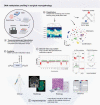DNA methylation profiling as a model for discovery and precision diagnostics in neuro-oncology
- PMID: 34725697
- PMCID: PMC8561128
- DOI: 10.1093/neuonc/noab143
DNA methylation profiling as a model for discovery and precision diagnostics in neuro-oncology
Abstract
Recent years have witnessed a shift to more objective and biologically-driven methods for central nervous system (CNS) tumor classification. The 2016 world health organization (WHO) classification update ("blue book") introduced molecular diagnostic criteria into the definitions of specific entities as a response to the plethora of evidence that key molecular alterations define distinct tumor types and are clinically meaningful. While in the past such diagnostic alterations included specific mutations, copy number changes, or gene fusions, the emergence of DNA methylation arrays in recent years has similarly resulted in improved diagnostic precision, increased reliability, and has provided an effective framework for the discovery of new tumor types. In many instances, there is an intimate relationship between these mutations/fusions and DNA methylation signatures. The adoption of methylation data into neuro-oncology nosology has been greatly aided by the availability of technology compatible with clinical diagnostics, along with the development of a freely accessible machine learning-based classifier. In this review, we highlight the utility of DNA methylation profiling in CNS tumor classification with a focus on recently described novel and rare tumor types, as well as its contribution to refining existing types.
Keywords: DNA methylation; brain tumor; neuro-oncology.
© The Author(s) 2021. Published by Oxford University Press on behalf of the Society for Neuro-Oncology.
Figures



References
-
- Tost J. DNA methylation: an introduction to the biology and the disease-associated changes of a promising biomarker. Methods Mol Biol. 2009;507:3–20. - PubMed
-
- Jones PA. Functions of DNA methylation: islands, start sites, gene bodies and beyond. Nat Rev Genet. 2012;13(7):484–492. - PubMed
-
- Louis DN, Perry A, Reifenberger G, et al. . The 2016 world health organization classification of tumors of the central nervous system: a summary. Acta Neuropathol. 2016;131(6):803–820. - PubMed
Publication types
MeSH terms
Grants and funding
LinkOut - more resources
Full Text Sources
Miscellaneous

